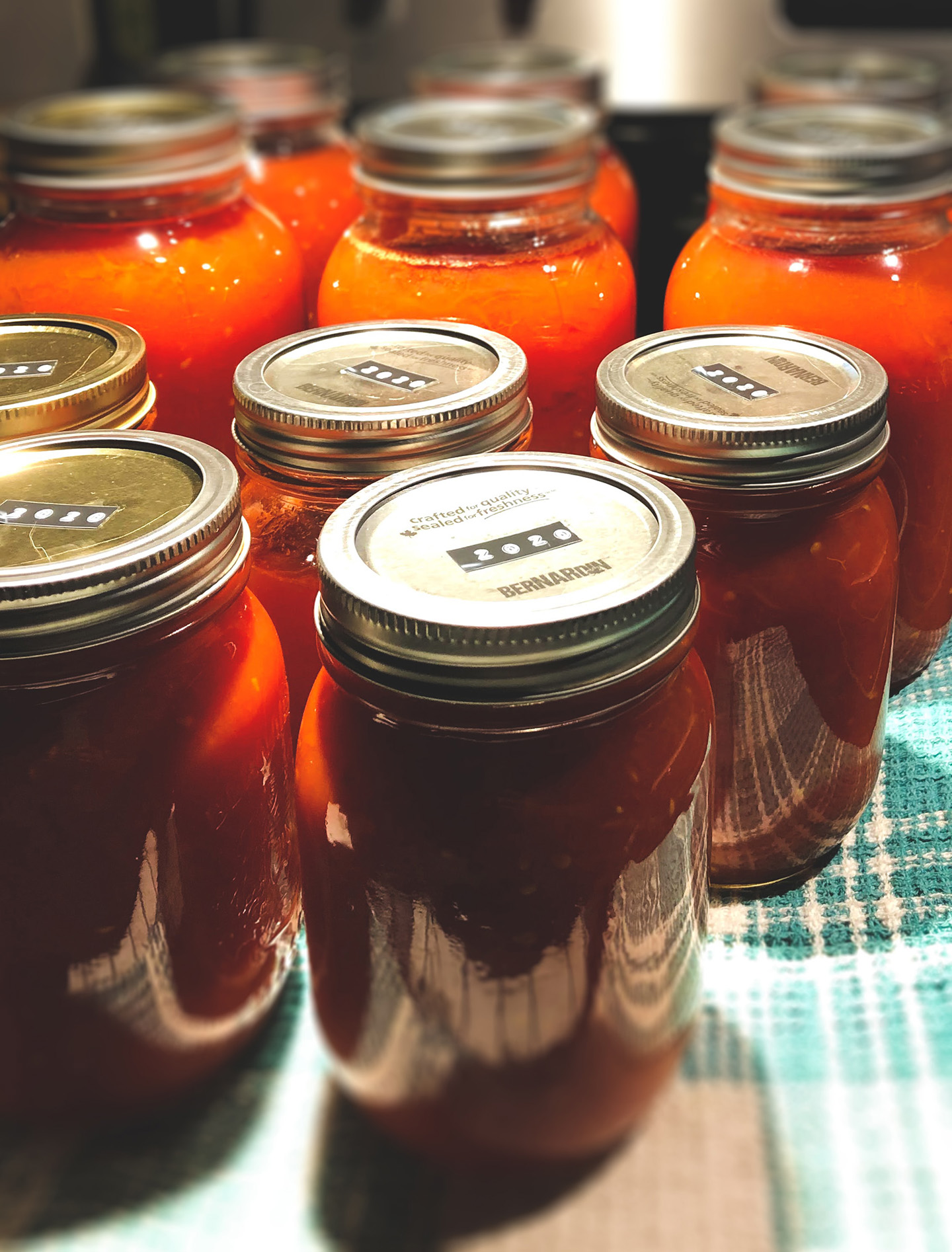Home Canning
Jars and Lids
This page will explain everything you need to know about recommended jars and lids, preparation of jars and buying and using lids and screw bands.
Regular and wide-mouth Mason-type, threaded, home-canning jars with self-sealing lids
are the best choice. They are available in 1/2 pint, pint, 1-1/2 pint,  quart, and 1/2 gallon sizes. The standard jar mouth opening is about 2-3/8 inches.
Wide-mouth jars have openings of about 3 inches, making them more easily filled and
emptied. Half-gallon jars may be used for canning very acid juices. Regular-mouth
decorator jelly jars are available in 8 and 12 ounce sizes. With careful use and handling,
Mason jars may be reused many times, requiring only new lids each time. When jars
and lids are used properly, jar seals and vacuums are excellent and jar breakage is
rare.
quart, and 1/2 gallon sizes. The standard jar mouth opening is about 2-3/8 inches.
Wide-mouth jars have openings of about 3 inches, making them more easily filled and
emptied. Half-gallon jars may be used for canning very acid juices. Regular-mouth
decorator jelly jars are available in 8 and 12 ounce sizes. With careful use and handling,
Mason jars may be reused many times, requiring only new lids each time. When jars
and lids are used properly, jar seals and vacuums are excellent and jar breakage is
rare.
Most commercial pint and quart size mayonnaise or salad dressing jars may be used with new two piece lids for canning acid foods. However, you should expect more seal failures and jar breakage. These jars have a narrower sealing surface and are tempered less than Mason jars, and may be weakened by repeated contact with metal spoons or knives used in dispensing mayonnaise or salad dressing. Seemingly insignificant scratches in glass may cause cracking and breakage while processing jars in a canner. Mayonnaise-type jars are not recommended for use with foods to be processed in a pressure canner because of excessive jar breakage. Other commercial jars with mouths that cannot be sealed with two-piece canning lids are not recommended for use in canning any food at home.
Jar Cleaning
Before every use, wash empty jars in hot water with detergent and rinse well by hand, or wash in a dishwasher. Unrinsed detergents may cause unnatural flavors and colors. These washing methods do not sterilize jars. Scale or hard-water films on jars are easily removed by soaking jars several hours in a solution containing 1 cup of vinegar (5% acidity) per gallon of water.
Sterilization of Empty Jars
All jams, jellies, and pickled products processed less than 10 minutes should be filled into sterile empty jars. To sterilize empty jars, put them right side up on the rack in a boiling-water canner. Fill the canner and jars with hot (not boiling) water to one inch above the tops of the jars. Boil 10 minutes at altitudes of less than 1,000 ft. At higher elevations, boil one additional minute for each additional 1,000 ft elevation. Remove and drain hot sterilized jars one at a time. Save the hot water for processing filled jars. Fill jars with food, add lids, and tighten screw bands.
Empty jars used for vegetables, meats, and fruits to be processed in a pressure canner need not be presterilized. It is also unnecessary to presterilize jars for fruits, tomatoes, and pickled or fermented foods that will be processed 10 minutes or longer in a boiling-water canner.
Lid Selection, Preparation, and Use
The common self-sealing lid consists of a flat metal lid held in place by a metal screw band during processing. The flat lid is crimped around its bottom edge to form a trough, which is filled with a colored gasket compound. When jars are processed, the lid gasket softens and flows slightly to cover the jar-sealing surface, yet allows air to escape from the jar. The gasket then forms an airtight seal as the jar cools. Gaskets in unused lids work well for at least five years from date of manufacture. The gasket compound in older unused lids may fail to seal on jars.
Buy only the quantity of lids you will use in a year. To ensure a good seal, carefully follow the manufacturer's directions in preparing lids for use. Examine all metal lids carefully. Do not use old, dented, or deformed lids, or lids with gaps or other defects in the sealing gasket.
After filling jars with food, release air bubbles by inserting a flat plastic (not metal) spatula between the food and the jar. Slowly turn the jar and move the spatula up and down to allow air bubbles to escape. Adjust the headspace and then clean the jar rim (sealing surface) with a dampened paper towel. Place the lid, gasket down, onto the cleaned jar-sealing surface. Uncleaned jar-sealing surfaces may cause seal failures.
Then fit the metal screw band over the flat lid. Follow the manufacturer's guidelines enclosed with or on the box for tightening the jar lids properly.
Do not retighten lids after processing jars. As jars cool, the contents in the jar contract, pulling the self-sealing lid firmly against the jar to form a high vacuum.
- If rings are too loose, liquid may escape from jars during processing, and seals may fail.
- If rings are too tight, air cannot vent during processing, and food will discolor during storage. Over tightening also may cause lids to buckle and jars to break, especially with raw-packed, pressure-processed food.
Screw bands are not needed on stored jars. They can be removed easily after jars are cooled. When removed, washed, dried and stored in a dry area, screw bands may be used many times. If left on stored jars, they become difficult to remove, often rust and may not work properly again.
